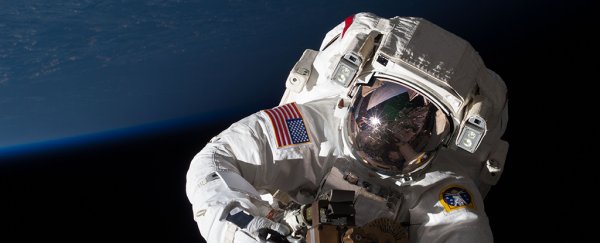When exposed to weightless conditions, astronauts can really pick up a temperature, new research reveals. This kind of 'space fever' comes on even when the body is at rest, and this strange finding is giving us more insight into how human beings cope outside of Earth's orbit.
The temperature rises don't come on instantly though – they develop over a period of months as the body adjusts to life in space without gravity, based on measurements taken before, during, and after trips to the International Space Station (ISS).
After two-and-a-half months, astronaut body temperatures regularly exceeded 40°C (104°F) during exercise, reports the team of scientists, and went 1°C above the normal level of around 37°C (98.6°F) even when the astronauts weren't doing anything at all.
"We developed a new technology which combines a skin surface temperature sensor with a heat flux sensor, and which is capable of measuring even minor changes in arterial blood temperature," explains one of the researchers, Hanns-Christian Gunga from the Charité Universitätsmedizin Berlin clinic in Germany.
The study was part of an ongoing effort to study how we might cope with extended trips in space, but so far little research has been done into how weightlessness affects the core body temperature (CBT), something that's very tightly regulated by our internal biological systems here on Earth.
Using the new ultra-sensitive sensors, which are placed on the forehead, the researchers got readings from 11 astronauts at various points during their time on board the ISS, starting 90 days before their first launch flight and ending 30 days after they got back.
On top of the general temperature rises, the results showed the human body's CBT rising faster in microgravity than it does on Earth.
That's likely because the space environment interferes with the key factors that regulate body temperature, including the heat we give off into our surrounding environment, and the amount of sweat we produce to cool down.
Sweat evaporates more slowly in space, for instance, which means overheating during exercise sessions on board the ISS becomes a potential problem.
"Under weightless conditions, our bodies find it extremely difficult to eliminate excess heat," says Gunga. "The transfer of heat between the body and its environment becomes significantly more challenging in these conditions."
This matters because regulating body temperature is crucial to our health and well-being – the National Institute for Occupational Safety and Health (NIOSH) in the US recommends that CBT shouldn't exceed 38.0°C (100.4°F) for the average person involved in heavy work on a daily basis.
What we don't want to see are problems like hyperthermia or heat stress while we're all on our way to Mars, so more research is going to be required to see how extensive this 'space fever' is and how we can combat it.
Besides the implications for space travel, the research also highlights issues about how our bodies could evolve to safely adjust CBT, and might have done so in the past. Given enough time, we might be able to tweak our own CBT to fit in with life in space.
"Our results also raise questions about the evolution of our optimum core body temperature: how it has already adapted, and how it will continue to adapt to climate changes on Earth," says Gunga.
The research has been published in Scientific Reports.
